“It’s hard, keeping your heart open. It makes you vulnerable.
But it doesn’t make you weak.”
I’ve loved big, sweeping sci-fi/fantasy stories for as long as I can remember—watching the final season of She-Ra and the Princesses of Power is the first time I felt like one of them truly loved me back.
There has always been a Horde Prime. We know that. We know what it is to face a vicious, self-obsessed imperialist. An ancient evil, adapted to modern tech. He’ll take a new vessel when his old one fails, but his rhetoric remains the same: do as I do, think as I think, or I will destroy you. That rhetoric is embedded in everyone who fears otherness, which they define exclusively in relation to their own experience: Horde Prime wants his way of life to dominate all life, even if it means destruction. Even if it means the very end of the world.
Noelle Stevenson has stated that Horde Prime is based on cult leaders, specifically suicide cult leaders, and also that there are elements of organized religion in the design of his ship.
I, like many queer viewers, know what it means to be “brought into the light.”
I, like many queer viewers, know what it is to have been told by authority figures, by our community, by the media we were shown as children—if you do not conform to my morality, you are inferior, and I will burn it out of you.
I, like many queer viewers, know what it is to grow up thinking that my love is weakness. That my powers aren’t enough.
She-Ra’s princesses are anathema.
They thrive on their individual powers and design, their community, how they constantly grow and learn from each other, supporting each other, fighting alongside together.
Horde Prime hates this. No, he doesn’t even hate it—he doesn’t bother. He just is unwilling to trust that anything other than his way of existence is worth preserving.
The princesses are the antithesis of Horde Prime’s ego, as is the very fabric of She-Ra’s queernormative storytelling. The multitudes of queer rep and the inherent queernormativity of the worldbuilding means that no one queer person or indeed no one queer couple has to bear the weight of representing the community.
She-Ra’s season five highlights how yes, this is high fantasy, but it’s also an alien invasion story. and pretty much all alien invasion stories have an undercurrent of colonizer panic—but She-Ra makes this obvious, the true villainous mastermind, the insidious reach of his rhetoric. Horde Prime’s influence in Hordak shaped the insecurities Catra and Adora have to work through, their childhood that taught them kindness and love was weakness, that magic and friendship was to be feared. While Catra, Scorpia, Entrapta, and Hordak can all choose to work to be redeemed, Horde Prime’s selfish cruelty is the seed of their villainy, and, as we know, some people will never change. They don’t want to. They have to want to.
Buy the Book


Over the Woodward Wall
Look at Wrong Hordak, cut off from the hivemind—terrified, unused to thinking for himself. “I am alone,” he weeps. Hordak was cut off and alone too. But Wrong Hordak fell into the arms of people who would welcome him, encourage his individuality, show him how to be a force for kindness. Hordak, on the other hand, remained alone, and he manifested as much of Horde Prime’s influence as he could to try and prove himself and get back to the hivemind and his master. It’s only because of Entrapta that he eventually fights back.
Horde Prime sees love as a vulnerability. She-Ra’s princesses know that he’s right—and that vulnerable doesn’t mean powerless, but instead known. Seen, unguarded—included.
If you make the choice to do the work, they’re there to help you learn—be it Catra working on her anger with Melog, or Wrong Hordak figuring out how to be his own person, guided by Entrapta. Or Scorpia hearing Perfuma even in her brainwashed, chipped state in season 5, episode 10, as the Plumerian plant princess declares: “Friendship isn’t a weakness. It’s my greatest strength. And it’s Scorpia’s, too.”
In opposition to the homogeneity of the Horde, within She-Ra’s ever-growing queer found family, you get to come as you are. She-Ra queers fantasy archetypes, blending the princess and the knight, the hero and the rogue, the soldier and the martyr, subverting expectations. And within their deliberately inclusive, diverse cast, they can call each other out when they’re wrong. They can learn together. Everyone has different levels of experience and ability, different ways of seeing the world and approaching a fight, and that makes them a stronger team.
And She-Ra doesn’t put the weight of someone’s healing on one person. Instead, everyone is supported by their community in turn: Entrapta never would have been able to help Hordak without the trio’s influence. Adora never would have learned the truth about the Horde if it wasn’t for Bow and Glimmer. They create an ever-expanding environment for forgiveness and growth.
That said, we only see the beginning of most of their redemptions. We see Scorpia and Entrapta actively fighting the side they once helped, we see Catra choosing to change, apologize, and atone. The show cuts off before we get a full redemption—and as Mermista says, seeing Hordak joining the princesses, “so are we just like, okay with this?” No, they haven’t undone the harm they’ve caused, it’s going to take more than a cute sneeze and a common enemy to do that. They’re only starting to, and they want to—just like Adora, when she first left the Horde. Just like Glimmer, when she apologizes to Bow for her frankly disastrous choices at the end of season four. Her choices were made in grief, and most of the others’ were under the influence of evil dictators—but they performed those evil acts anyway.
No one’s asking anyone to be perfect. Heroes aren’t born, and they’re not done after one good act. Heroes—like the princesses, like the Star Siblings—are people who have fucked up before, who are scared, who can be cruel, who choose to try to do better, as often as they can. And for me, I’m willing to believe in the beginning of these redemption arcs because they’re positioned in opposition to the end of Horde Prime. Not everyone wants to change, and some evils just need to be eradicated at the source. From there, and only from there, we can begin to grow.
And crucially, unlike most other mainstream SFF narratives, She-Ra doesn’t let otherness stay a metaphor.
***
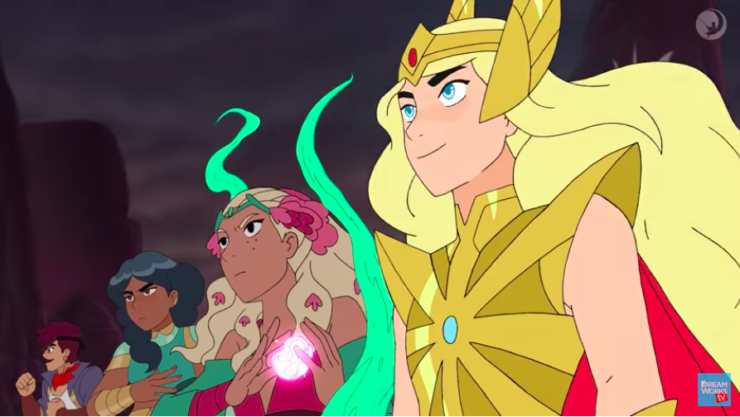
From the very first season of the show, I felt at home in its deliberate inclusivity. She-Ra and the Princesses of Power makes a point to feature a cast of characters that’s diverse across body type, race, gender presentation, and species. It’s specifically designed to highlight different means of expressing power—literalizing the idea that there’s infinite ways to be a “strong woman.” We get a whole range of superhero girls, including a star who’s muscular, feminine, loving, flawed, and queer, all at once. And there’s not only room for an expansive exploration of femininity—for a range of women who fight, lead, love, loathe, and grow, who are never defined by men—but also for an expansive exploration of healthy masculinity. She-Ra’s men are just as diverse, and rendered with just as much care. With Bow, Seahawk, Micah, Lance, and George, we not only get an array of women superheroes with their own powers and storylines, but examples of how to write diverse, non-toxic men and loving relationships with men—including crucially important narratives of non-toxic fathers. She-Ra operates as far outside the gender binary as I’ve ever seen a children’s show do, not only because of their inclusion of multiple trans characters, but because the cis-aligned characters don’t confirm to any binary at all. There are no gender roles or compulsory cisheterosexuality anywhere on the planet.
She-Ra knows the fantasy tropes we love—and they know that there are so many queer nerds who have spent their lives loving these narratives without feeling like they belonged inside them. Or, if we do, only as the sidekick, the coded villain, the comic relief, the token. She-Ra gives us what we don’t always get to have: prolonged, complicated storylines, and desire that’s central to the story.
She-Ra subverts pretty much every trope it meets, and in so doing, it tells a more fulfilling, cathartic story. What is a subversion if not an unmasking? This is what you’ve taken for granted, and this is the heart of it. There is another way.
The return of the king: No patriarchal systems here, the princesses rule their own lands, they do not answer to a king—and when Micah returns to Brightmoon, it isn’t even an option that Queen Glimmer would give up her throne. And Micah has no interest in having her do so.
The sword that was broken: Adora’s identity as She-Ra isn’t tied into the reforging of a weapon. Her power lies in the fierceness of her love.
The chosen one will sacrifice everything to save the world and rule the planet: There is something broken in how we talk about heroes, in how we position righteousness as inherent and immovable, and this makes the final scene with Mara one of the most poignant in the show. There is something broken in how we position the ultimate sacrifice as an entirely selfless act, as if martyrdom is aspirational and even imminent, instead of envisioning a world in which we can live with the complexity of our choices, and perform the messy work of rebuilding. In which we recognize that we all have strengths and weaknesses, that it’s not too late to do one good thing, and heroism is choosing to be better, to work together, again and again—and not leave anyone behind.
The love interest is a trophy to be won: in particular, the episodes “Save the Cat” and the finale both say a big fuck-you to this one. Fuck your trophy, your hero, your knight in shining armor, your damsel in distress.
Adora and Catra both hurt each other. And Adora and Catra both save each other.
***
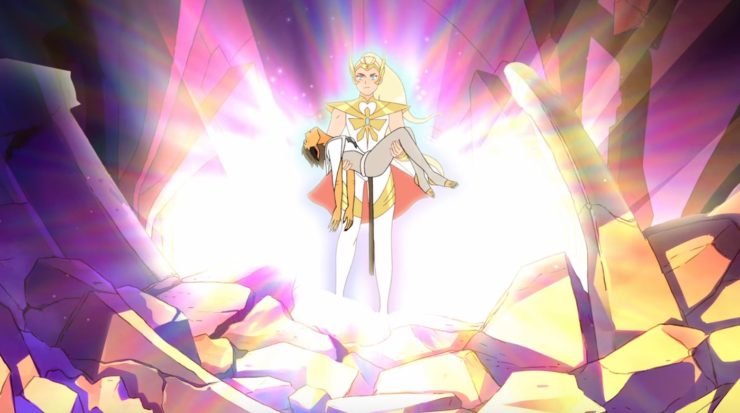
There are lots of impactful moments in the rebuilding of their relationship, but two instances in season five keep replaying in my head.
The entirety of “Save the Cat” is a masterpiece of queer storytelling, especially that scene of She-Ra rescuing Catra evoking both the cover of a romance novel and Michaelangelo’s Pietà. But the most intimate moment to me was when they’re safe, back on the ship, and she’s Adora again:
Come on, Catra. You’re not done.
She knows Catra’s story isn’t over. She believes in Catra’s redemption, knows there’s more to her than a villain and a sacrifice. It’s almost “we’re not done,” but it’s less selfish than that. She knows that no matter what, Catra has more of her own story to write—though in that breathless, heart-wrenching moment, we can feel that Adora knows she wants to be a part of it.
and then, Catra’s words from the finale:
I’ve got you. I’m not letting go. Don’t you get it? I love you! I always have!
So please, just this once. Stay.
Catra won’t let Adora sacrifice herself either. And she wants to be a part of her story, too.
Their story takes so many turns, but by season five it’s one of so much hope. Of refusing to give up on each other, daring to envision a life they could build.
Catra leapt through fire for her, sacrificed herself to keep Adora safe, and Adora refused to let her. She walked into the clutches of the universe’s biggest villain to bring her back.
Their love isn’t linear. We get to watch it grow. Especially because there are other examples of queer love that gets to be long term and healthy. Bow’s fathers and their dad jokes, Spinnerella and Netossa and their battle tactics and their ruined anniversary—their on-screen, canon love means that Catradora doesn’t have to stand for The Queer Experience on the show, which allows for so much depth and pining, on top of some really terrible decisions. It’s not a straightforward dynamic, but it’s also not a tragedy. And it is never, ever forbidden or denigrated for being queer. It’s as nuanced and engaging as some of the best straight romances out there, but it explores the very familiar queer experience of being in love with your best friend and utterly incapable of communicating, and resolved with an emphasis on deliberate healing, growth, and parity. Two girls who are powerful in their own right, who see the full truth of each other, and choose each other.
***
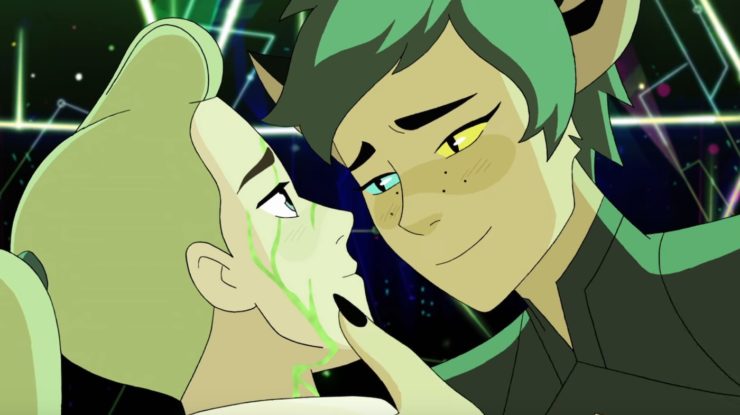
At the end of Pride 2020, Catradora will have been canon for just over a month. But that’s not exactly true—Noelle Stevenson and their crew fought for it every step of the way, so Catradora has actually been canon for years. Catra and Adora have always been in love with each other, and now it’s going to be canon forever. Not subtext or sideplot, but embedded in the very premise of the show, in its climax and in its purpose. And it always will be. We get to have that now. For this year’s Pride, and beyond.
We get to live in a world in which love of all kinds is power, and it can save: as it saves Spinnerella, and Micah, and Scorpia, even before their chips are deactivated.
A world in which the love of two queer girls gets to save the universe. They get to fight, to be terrifyingly angry, to be powerful, to deal with their own internalized toxicity, their sacrificial, overcompensating hero complex and their weaponized insecurity. They get to finally be honest with each other, and confess their love.
A world in which girls get to save each other. And build a future that they get to share.
Many queer viewers knew from the beginning that when Catra pushed Adora away, when she felt like she wasn’t enough for Adora to choose her, that she didn’t only mean as a friend. We know what that longing looks like, we know how it can make you lash out. “Not like I want her.” And this time, we not only get to be right, we get to see it resolve through a season of forgiveness, selflessness, and an actual, on-screen kiss and declaration of love. We get to experience queer catharsis and joy as the vindicating, triumphant centerpiece of the resolution.
And in this way, She-Ra doesn’t only give us a great love story. It does what all the very best stories do: it reshaped the world. It remakes this timeline into one in which we—all of us, but especially our children, the generation that’s going to build our future—get to watch girls make mistakes, want to be better, learn how to be better, forgive each other. A queer “I love you, too” with the power to save the universe.
***
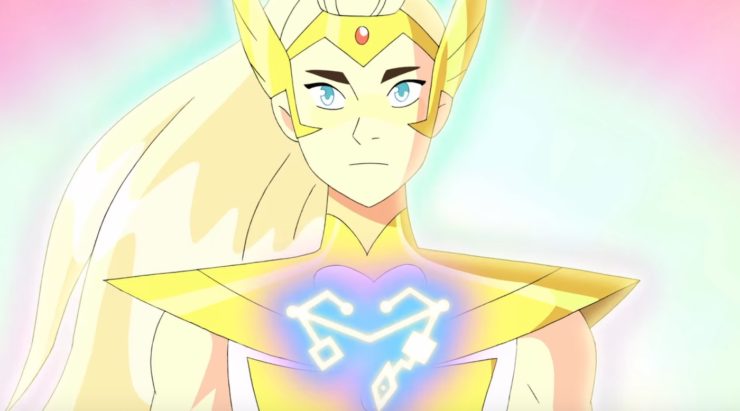
Yes, we need more. We need queer stories that center the action of that redemption, the messy, uncomfortable middle, the work toward a resolution. I want stories written with this much love in which diverse, queernormative superheroes get to reckon deeply with the internal and community fallout upon recognizing they were the villains. I want to watch Catras, Entraptas, Scorpias, Shadow Weavers, Wrong Hordaks actually live with the consequences of their actions—I want to watch them make amends, to show that growth, like grieving, is a process. I want Black, indigenous, POC queer storytellers to showrun cartoons that do the work of confronting the weight of redemption, that don’t try to redeem anyone complicit in colonization, and to showrun cartoons that don’t center colonizers at all. Yes, I want stories that don’t center a thin white blonde girl savior, no matter how queer they are.
But I wanted this too, and I am so grateful that Noelle Stevenson and She-Ra’s crew fought to give us as much as they did. To reboot a show for children and make sure more of us can see ourselves within it, to give us the dynamic SFF adventure we love and use it to embody queer love. To make this story as openly, defiantly queer, inclusive, and loving as it is, and I hope that next time, they don’t have to fight so hard. I am so grateful that we live in a world in which Korrasami, Bubbleline, Garnet, and now Catradora have nudged open the door a little wider, made more room for us, proved how fiercely we want these stories and how much they can mean. How impactful it is that a narrative can feature not only Catradora outside of heteronormativity, but Spinnerella and Netossa, George and Lance, Double Trouble, Jewelstar, Prince Peekablue, and the very fabric of the show. Just like no one queer character or couple can represent the entirety of the queer experience, no one show can encompass everything for everyone—and She-Ra works hard to subvert so many established narratives, in the service of representing a more authentic, inclusive universe.
So many queer viewers recognized ourselves in Catra from season one, and recognized the root of our fears in the true villain of season five. And in this final season, She-Ra said, we know. We see you. You’re right. You belong in this story, and you are not the villain. There is tenderness and joy on the horizon. Let us show you what it can look like.
In its very last act of subversion, She-Ra demonstrates how you don’t need either a bittersweet, half-tragic ending or a timeskip to deliver a satisfying finale—and their choices made it all the more cathartic. Let them come together in queer love, community, and joy. Let there be a wide open future brimming with hope and adventure, within reach. That’s how we save each other. That’s how we save the universe.
She-Ra’s happy ending works because it’s a beginning. And it celebrates the thrill of growth, love, and magic yet to come.
The universe is a scary place. But in watching She-Ra, I can’t help but feel like that you know what, yeah. The dream of that future is worth fighting for.
We’re gonna win in the end.
Maya Gittelman is a queer Pilipinx-Jewish diaspora writer and poet. Their cultural criticism has been published on The Body is Not An Apology and The Dot and Line. Formerly the events and special projects manager at a Manhattan branch of Barnes & Noble, she now works in independent publishing, and is currently at work on a novel.










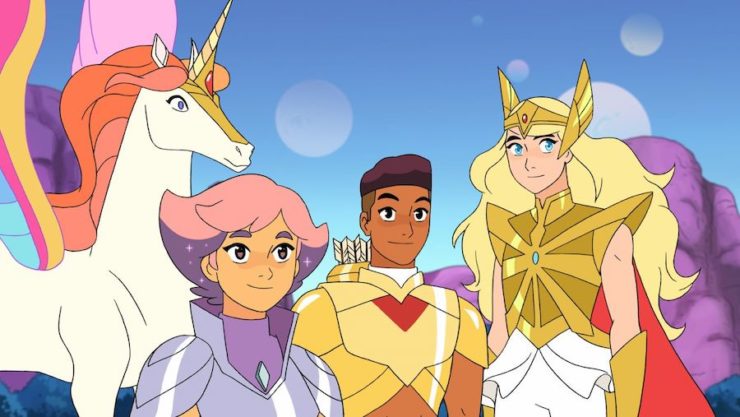
Hi Straight dad of two girls (8 & 10) here. We all love everything about this program, and I am so glad that I was able to share this with them as they are entering the middle-school years which I felt were for me a worse mine field than those high school years back in the days of the original She-Ra.
I cannot adequately describe how happy I was to have this program which is 100% about relationships and what you make of them, of the consequences of our words and actions, and the power of forgiveness and acceptance of your own and other’s attempts to change.
Though there is a part of me that, mostly because of where my daughters are in their own often combative relationship with each other, would have liked for Catradora to have cemented their best-friend sister bond at the end instead of cresting their romantic arc because dang it THAT is something I needed for them to see. Again, totally selfish, but I don’t have any way to model for them the messy turbulent relationships full of anger, jealousy, sadness, and pain that sisters go through and yet the love for each other is always there and can overcome the rest. But I guess I will just have to make do with “Frozen” for that along with the trials-and-tribulations of “the best friend squad”
We all hope to see some future continuing adventures one-off film length follow-up. My youngest was pitching me ideas of what she thinks comes next but refuses my suggestions to write them down; to be the author of these next chapters herself. Oh well, maybe when she turns 9 she will come around…
The world needs more programs just like this.
-i’m cishet and i cry every single time i watch corridors and the last episode. i cried just reading this article, i have to make sure i keep myself together when driving so my vision isn’t blurred
-as a cartoon watching millennial, i can say she-ra is a show that i’ve been waiting for for years. my sister watched sailor moon but i wasn’t in to it and the U.S. censored it. i initially ignored she-ra because i assumed it would be hamfisted and i heard about the electrical socket thing (which i still don’t like) leading up to entrapta being left in the fright zone. my sis was the one that got me to watch it and now i think about this show every day.
-redemption arcs are an important moral landmark. maybe I just like dystopian and dark tragedies like age of apocalypse, but i hope that if there is more she-ra, it will be darker. besides redemption characters like former villains in dbz, Sullivan from Secret of NIMH is underrated. watching the last scene in that taught me you should do the right thing even in the last moments of your life, even without reward. read the article “the melancholy of don bluth”
-i hope we see horrors the star siblings had to survive, main characters carry guns, writers deal with a power vacuum after horde prime, netossa as a yang wenli tier general
One of the single greatest joys I have as a parent is watching my kids throw themselves down a fandom rabbit hole; to get excited about something, to draw fanart, to speculate for hours about what’s going to happen next, to see their faces light up with that particular geek-ish joy.
This show was my 8yo’s gateway Noelle Stephenson experience — she’s since discovered LumberJanes and Nimona — and it has been so. much. fun to watch her absorb the ideas and lessons it lays out. I have no idea, yet, who she’s going to love or how her identity will continue to develop, and I am so grateful that one of the main strengths of this show has been to lay out joyfully and never didactically the validity and beauty of so many different kinds of relationships, both platonically and romantically — and how people can love each other and still hold each other accountable for their mistakes. I hope it makes her journey a little bit easier. I feel a little bit more like a decent parent for having introduced her to this show and seized the opportunities for dialogue it has offered.
Also: Kyle/Rogelio 5EVA
It’s truly mindblowing how both Catra and Adora have been confirmed to be not only queer, but LESBIANS, by Noelle herself, yet that’s not a word you use for them even once in this article. Even while writing on the beauty of inclusivity, you’re perpetuating lesbophobic actions. Sad to see. Lesbian is not a dirty word.
This show is so important. The ending made me feel like I would burst from all the feelings.
Couldn’t have said it better. I just found this new She-Re in the last month and a half and , while straight, an glad to know I’m not the only person who has bawled like a baby through many episodes ( “Save The Cat” and “Heart”1 &2). I forget the episode titles but the season 3 finale and the season 4 opener both blindsided and amazed me. At the end of season 3 I figured Adora/She-Ra would be trapped but somehow miraculously released during season 4…I never saw the true storyline coming and it broke my heart. Don’t even get me started on “Save the Cat” which is most likely my favorite of the 52….the scene with our reborn hero with a nearly dead Catra in her arms is a gorgeous work of art in so many levels…followed by the weak voices “hey Adora” at the end. This after the horror of seeing Catra as part of the hive mind…I was so ready to slap somebody during that part of the story that when She-Ra finally reappears all I could think was “kick his behind.”
Noelle and her team are marvelous writers, but they are blessed beyond words with a set of voice actresses / actors second to none. If you listen to it carefullt, there is a different tone , cadence, pitch in nearly every one of Carerro’s calls “for the honor of Greyskull” and it adds unbridled realism to the show. Her heart to heart with Catra are the stuff of legend.
For my money it’s a full blown masterpiece and the She-Ra I always wanted.
Well said all around. Such a great show!
hi! catra and adora are lesbians, please refer to them as such! i know queer is the standard academic term but it erases identities and goes against the point of this well-intentioned piece
I’m crying. Thank you.
Here’s to a future of more, more diverse, and continually excellent queer media.
Before I comment I wish to say I am Trans.
I grew up watching and loving the original She-ra series.
I found the story fun and enjoyable but I also found all the LGBT overly forced. I loved the inclusivity of different ethnicities and some gay and lesbian couples. But as the show wore on every single couple was gay or lesbian. This turned what started as a great inclusivity that had me wishing to learn more about these characters into an annoying preaching of LGBT superiority campaign.
This show greatly illustrates that to much of something is just as story breaking as to little. I have long wished for shows to showcase strong LGBT couples without relegating them to comical support. This She-ra did a great job of that at first. But unfortunately greatly damaged the setting by hamfisting everything to be LGBT. Leaving the feeling one is either in a LGBT world or a Straight world. That there is no room for both.
With so many LGBT couples I was against Catra and Adora being a couple as it had just been made blah and pointless. If there had been a few less LGBT couples forced our way I feel Adora and Catra would have been more impactful.
I hope this failure of balance isn’t repeated in future shows.
I couldn’t agree more with the above article.
I grew up watching the 80’s original, so I decided to check out the artwork of the upcoming reboot. And I was blown away. They looked their ages! And the diversity! And different body types! I was so excited to watch. Then I started to detect what I thought was queercoding in a villain, and bating in the story, and I assumed that’s all I would get out of this cartoon. And then it was all made canon, and my gay heart cried with joy. Imagine, if I could have seen stories like this when I was a kid? I am so grateful to these writers for their hard work.
@13, of the couples that are either confirmed or strongly implied, we have a ratio of 5 same-sex couples (Netossa/Spinerella, Catra/Adora, Perfuma/Scorpia, Light Hope/Mara, and Bow’s dads), and 4 m/f couples (Entrapta/Hordak, Mermista/Sea Hawk, Glimmer/Bow, Glimmer’s parents). I’d say that’s pretty well-balanced, so I’m not sure why you think there were no m/f couples whatsoever – most of them even got big moments in the finale.
I love absolutely everything about this show. And there were straight couples and gay couples so I’m not sure what one of the other commenters on here is even talking about. Maybe they watched a different show. Shrugs.
I love how everyone came together in the end. I wish we could get more seasons or even a movie. I’d even settle for some comics/graphic novels, but I’ll help myself to fan fics for now. There are some really good She Ra fan fics lately. I don’t think I’m allowed to post them here sadly. Aw well.
As for another commenter, I can understand wanting a sister relationship modeled for their children, but in the show I personally never considered Adora and Catra to be sisters. They were child soldiers and it was made clear they had no concept of what family is. Frozen is good though for that.
Is the author allergic to saying “lesbian”? It’s not a dirty word. It’s fine if you don’t use it yourself, but those two characters are not generically “queer”. They’re not male, they’re not bisexual, they’re not trans, they’re not the multitude of things “queer” can mean. They’re lesbians. They’re two girls who only ever show interest in other girls. The distinction is important!
Sorry to everyone who felt the need to post negative comments on a piece so filled with joy; I think you missed the point.
To Maya the author : I just finished the finale a couple of days ago and I’ve had this post open in a tab waiting to be read for a long time. You’ve captured so many of my thoughts on the finale and the series as a whole, and it’s really lovely to see my own poignant teary happiness put into words. Thanks for writing about how great She-Ra is.
I’ve had this article bookmarked for ages and finally sat down to read it. This is so wonderfully written. I felt teary-eyed a few times, but in really good ways. Thank you for sharing this perspective.